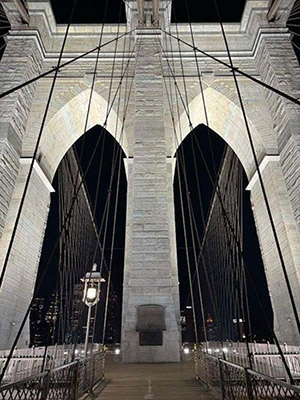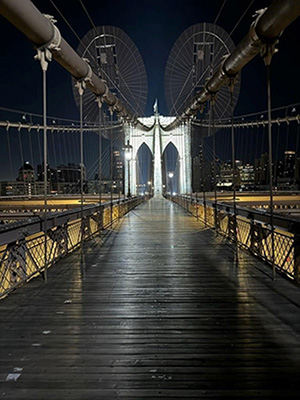Press Releases
IMMEDIATE RELEASE
January 11, 2024
Contact: (212) 839-4850, press@dot.nyc.gov
NYC DOT Celebrates Brooklyn Bridge New Year's 'Glow Up'
New Energy Efficient Lights Will Illuminate ‘America’s Eiffel Tower,’ Highlight Transformative Restoration Work
NEW YORK – New York City Department of Transportation (NYC DOT) Commissioner Ydanis Rodriguez today announced that the Brooklyn Bridge received a major new year’s ‘glow up.’ The iconic 140-year-old bridge, which historian David McCullough famously called ‘America’s Eiffel Tower,’ will be lit with bright, energy efficient LED lights beginning this evening. A total of 56 new lights will illuminate the bridge’s distinctive towers. NYC DOT will commemorate the new lighting system going live at an event this evening at 5:00 p.m. in Brooklyn Bridge Park.


The new lighting system is part of NYC DOT’s efforts to preserve this beloved global landmark, a UNESCO World Heritage site. This year, NYC DOT will complete a four-year, $300 million project to meticulously scrub decades of harmful dirt and soot from every stone on the bridge, restore the mortar between each stone, and return the bridge’s famous towers to their original light gray color. The new lighting system cost $2.4 million and took five months to install. The system is expected to last for 20 years.
“Everyone loves a good new year’s ‘glow up,’ and thanks to our new energy efficient LED lighting system, the iconic Brooklyn Bridge will shine bright for all New Yorkers to enjoy,” said NYC DOT Commissioner Ydanis Rodriguez. “One of NYC DOT’s most cherished responsibilities is maintaining ‘America’s Eiffel Tower,’ and these new lights will showcase its beauty for decades to come.”
“The Brooklyn Bridge is one of New York’s most cherished landmarks, recognized the world over as a symbol of our city,” said Landmarks Preservation Commission Chair Sarah Carroll. “The Commission is proud to support initiatives like the Brooklyn Bridge’s new energy efficient LED lighting system, which demonstrate New York City’s powerful commitment to sustainability, as well as the ability of our historic buildings and sites to evolve to meet modern needs and contribute to a greener city in the years to come.”
The last time the bridge’s towers were illuminated was for its centennial celebration in 1983. The 166 necklace lights on its cables were converted to LED bulbs by NYC DOT in 2021.
An American Icon
Construction on the Brooklyn Bridge began in January 1869 and the bridge was the longest suspension bridge in the world when it opened on May 24, 1883. The bridge’s grand opening was met with great fanfare, including President Chester A. Arthur attending the festivities.
The bridge, which originally included trolley service, today accommodates vehicle traffic, includes a pedestrian walkway, and features dedicated bike lanes opened in 2021. An estimated 120,000 vehicles, 30,000 pedestrians, and 4,000 cyclists use the bridge each day.
Made of limestone, granite, brick, steel, and cement, the bridge’s recent restoration featured meticulous cleaning of every individual stone and brick. And, no glow up would be complete without exfoliating. While scrubbing the bridge improved its appearance, it also removed damaging grime from the pores of each stone. The mortar used to hold the stones together was also replaced using materials sourced from the same quarry as the original mortar. After decades of maintaining a brown appearance from generations of dirt, grime, and pollution, the deep clean restored the bridge’s towers to their original gray color.
As part of the bridge’s restoration, earlier this year Mayor Eric Adams announced the opening of The Arches, a public space under the bridge on the Manhattan side that features space for basketball, pickleball, shuffleboard, and public seating. The Arches is located next to the site once known as Brooklyn Banks, the original mecca of New York City skateboarding.
"The Brooklyn Bridge is as iconic as any New York celebrity, and now it's finally getting the spotlight it deserves," said State Senator Andrew Gounardes. "The new lighting is energy-efficient and keeps the bridge looking good. I'm grateful to the Department of Transportation for their efforts to preserve and care for this Brooklyn landmark."
“The Brooklyn Bridge has long been a beloved landmark for all to enjoy. I applaud DOT’s efforts to highlight our iconic bridge by adding energy-efficient LED lights. May generations to come delight in the bridge's beauty,” said Assemblymember Jo Anne Simon.
“The Brooklyn Bridge is one of New York City's crown jewels — I'm excited to see the new and improved energy-efficient lighting that it deserves!,” said Councilmember Lincoln Restler. Thank you to DOT for prioritizing this sustainability upgrade.
Brooklyn Bridge Fun Facts
- Construction began in January 1869.
- The bridge opened in May 1883.
- The bridge cost $15 million to build.
- Total length of the bridge and approaches: 6,016 feet.
- Length of the main span: 1,595.5 feet.
- Clearance at center: 135 feet.
- It was the world’s longest suspension bridge when it opened, and was also briefly the tallest structure in North America.
- The bridge has an unusually long approach extending inland on both the Manhattan and Brooklyn sides because of the city’s low-lying shores.
- The bridge originally had tolls for pedestrians, horse riders, horse and carriage riders, and even farm animals that were originally permitted on the span.
- When the bridge opened, New York City and Brooklyn were two different cities. Brooklyn became part of New York City in 1898.
- John A. Roebling, an immigrant from Germany, was the original architect for the bridge. He died in 1869 during preparation for the bridge’s construction. His son Washington A. Roebling became the bridge’s chief engineer. When Washington A. Roebling fell ill and became bedridden in 1872, his wife Emily Warren Roebling assumed management of the project. Widely credited as the person responsible for the bridge’s successful completion, she famously became the first person to ride across the completed span, holding a rooster, which at the time symbolized victory.
An earlier version of this release erroneously stated that the Brooklyn Bridge had been named a UNESCO World Heritage Site. The bridge remains under consideration for such status.
